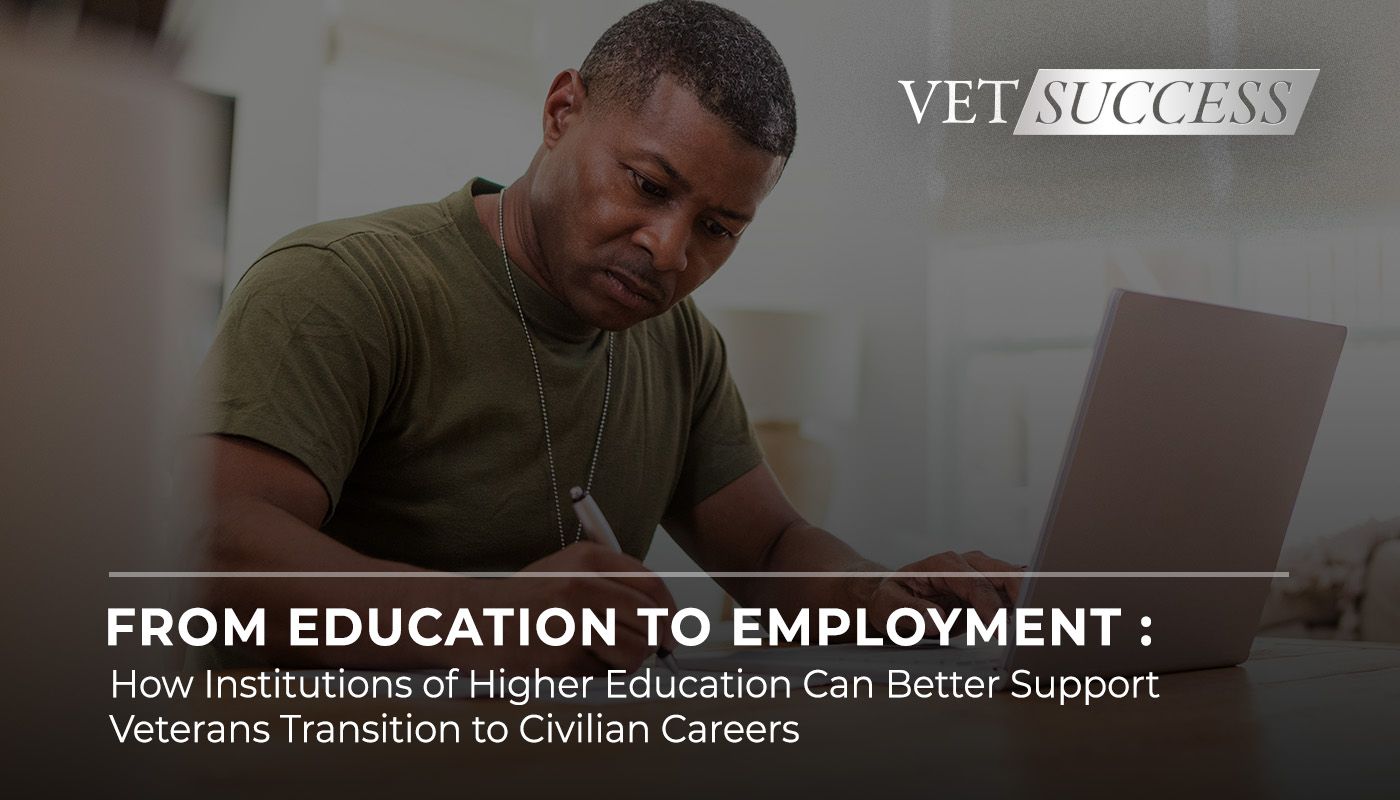
One of the most difficult barriers veterans face in their transition to civilian life is finding employment opportunities that are the right fit. Whether it’s an issue of underemployment or cultural misalignment and unfamiliarity, many veterans struggle to find and stay in positions after the service. Universities and institutions of higher education have long been a conduit for veterans transitioning to civilian careers and can play a powerful part in veterans’ long-term career success.
Veterans that pursue postsecondary education gain access to numerous experiences and resources that better position them to thrive in the civilian workforce. For example, employers may struggle to translate veterans’ transferrable military experience, but a degree from a postsecondary or vocational institution is a clear indication of veterans’ qualifications.
Continued education also provides veterans with the opportunity to upskill or explore industries they may not have had exposure to while in the service. Furthermore, in pursuit of their continued education, veterans become more familiarized with civilian terminology and professional norms and can access valuable networking opportunities.
However, while institutions for higher learning offer a myriad of benefits that support students’ career aspirations broadly speaking, they are not always prepared to accommodate student veterans’ specific life circumstances or professional development needs. To best support student veterans’ professional aspirations, postsecondary institutions need to familiarize themselves with the unique opportunities and challenges their student veterans face, both while in school and in the workforce.
American Veterans Group sat down with Hudson Miller, United States Marine Corps veteran, recent Harvard University graduate, and former president of the Harvard Undergraduate Veterans Organization to discuss some of the barriers student veterans face, and how universities can better support their veteran student population.
How can postsecondary institutions better support their student veterans and set them up for long-term career success?
Gain a clear picture of the institutions’ student veteran population.
Career development and postsecondary offices that provide student support should keep in mind that the majority of student veterans have similar profiles to other “nontraditional” students. The Institute for Veteran and Military Families and the Student Veterans of America
report that 47% of student veterans are married and have one or more children, 85% are between 24 and 40, 62% are first generation college students, and 60% of student veterans are employed, working 35 hours a week on average. Miller emphasized that while student veterans share common life circumstances as other “non-traditional” students, universities need to be careful not to simply lump veterans into this group, and must walk the fine line of accommodating student veterans’ specific needs while not isolating them from the rest of the student population.
“Getting them in the door is incredible, but you still need to take care of them – and you need to take care of them in the way they need to be taken care of,” Miller asserted, “not in the way that everyone is being taken care of.”
Each postsecondary institution should know the specific demographics of its student veterans to better anticipate and accommodate their needs, whether it be providing flexible course hours, or connecting them with university childcare providers.
“You’ve built a program that’s designed to help 18- to 22-year-olds who are single, who haven’t had a job before, and all these things are great,” Miller continued, “but you now need to expand on that.”
Universities also need to be prepared to support student veterans transition to campus life – whether it be providing resources and information related to mental health supports, or campus culture guides. The first step in supporting student veterans advance in their civilian careers is removing barriers that may prevent them from exceling in their education, including barriers to social acclimation on campus.
Advocate for veteran representation in postsecondary administration.
Veteran representation in post-secondary administration enables institutions to better develop policies and resources that enable student veteran success. For example, having individuals in the career development departments of universities who are either veterans themselves, or have been trained in the veteran transition process are better-equipped to place and advocate for student veterans through their job search. The Institute for Veterans and Military Families
reports that “campuses with personnel dedicated to serving student veterans were described as being better equipped to engage with employers, VSOs, and community-based organizations.”
While reflecting on his own experience transitioning from service to university, Miller said. “If you’re to have success, I think you need somebody within the institution who’s willing to push for you.”
Given the different experiences, challenges, and needs of student veterans, it’s necessary for postsecondary institutions to ensure they have a voice at the administrative level.
“I think it would be nice to have somebody at the institutional level to be like, ‘hey, this is what our mission is for veterans and this is how we get there,’” Miller said.
Create a central student veteran career hub.
It can be difficult and overwhelming to find and leverage relevant career resources. By housing this information in a central hub, whether it be a portal on the university’s website, or a monthly newsletter, student veterans can more easily access training opportunities and job postings.
For Miller, networking has played a powerful role in both his university and post-graduate success, but he also explained that it isn’t always easy for student veterans to find the connections they need.
“Veterans honestly don’t know what they’re qualified to do when they’re looking for internships,” he said, “there’s not a lot of resources for finding internships that are specifically looking for veterans either.”
With this in mind, postsecondary institutions can also use these hubs as a repository for student information; for example, student veterans may submit their resumes and preferred industries so the career and development office can connect students with tailored opportunities.
By offering tailored assistance, institutions can bridge the gap between military experience and the civilian job market, helping veterans translate their skills and qualifications into meaningful employment opportunities.


